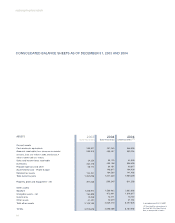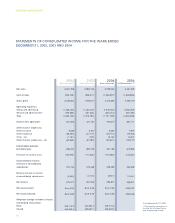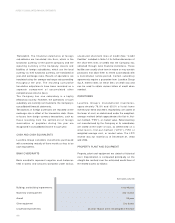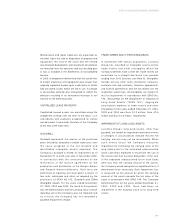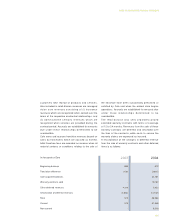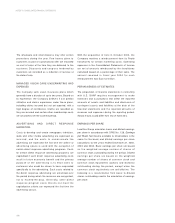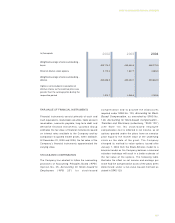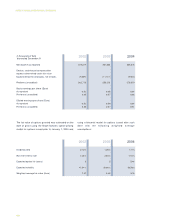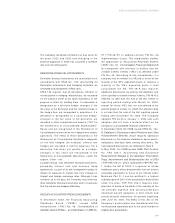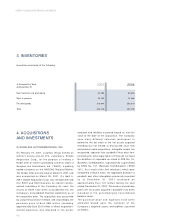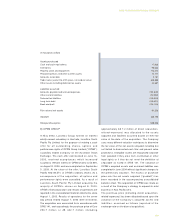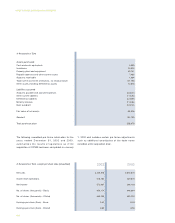LensCrafters 2004 Annual Report Download - page 105
Download and view the complete annual report
Please find page 105 of the 2004 LensCrafters annual report below. You can navigate through the pages in the report by either clicking on the pages listed below, or by using the keyword search tool below to find specific information within the annual report.NOTES TO CONSOLIDATED FINANCIAL STATEMENTS
104
STORE OPENING AND CLOSING COSTS
Store opening costs are charged to operations as
incurred in accordance with Statement of Position No.
98-5, Accounting for the Cost of Start-up Activities. The
costs associated with closing stores or facilities are
recorded at fair value as such costs are incurred. Store
closing costs charged to the Statements of
Consolidated Income during fiscal years 2002, 2003
and 2004 were not material.
SELF INSURANCE
The Company is self insured for certain losses
relating to workers’ compensation, general liability,
auto liability, and employee medical benefits for
claims filed and for claims incurred but not reported.
The Company’s liability is estimated on an
undiscounted basis using historical claims
experience and industry averages; however, the final
cost of the claims may not be known for over five
years. As of December 31, 2003 and 2004 self
insurance accruals were Euro 18.6 million and Euro
36.1 million, respectively.
INCOME TAXES
Income taxes are recorded in accordance with SFAS
No. 109, Accounting for Income Taxes, which
requires recognition of deferred tax assets and
liabilities for the expected future tax consequences
of events that have been included in the Company’s
consolidated financial statements or tax returns.
Under this method, deferred tax liabilities and assets
are determined based on the difference between the
consolidated financial statement and tax basis of
assets and liabilities using enacted tax rates in effect
for the year in which the differences are expected to
reverse. A valuation allowance is recorded for
deferred tax assets if it is determined that it is more
likely than not that the asset will not be realized.
LIABILITY FOR TERMINATION INDEMNITIES
Termination indemnities represent amounts accrued
for employees in Australia, Austria, Greece, Israel, Italy
and Japan, determined in accordance with labour
laws and agreements in each respective country (see
Note 9).
REVENUE RECOGNITION
Revenues include sales of merchandise (both
wholesale and retail), insurance and administrative
fees associated with the Company’s managed vision
care business, eye exams and related professional
services, and sales of merchandise to franchisees
along with other revenues from franchisees such as
royalties based on sales and initial franchise fee
revenues.
Wholesale division revenues are recorded from sales
of products at the time of shipment, as title and the
risks and rewards of ownership of the goods are
assumed by the customer at such time. The products
are not subject to formal customer acceptance
provisions. In some countries, the customer has the
right to return products for a limited period of time
after the sale. However, such right of return does not
impact the timing of revenue recognition as all
conditions of SFAS No. 48, Revenue Recognition
When Right of Return Exists, are satisfied at the date of
sale. Accordingly, the Company has recorded an
accrual for the estimated amounts to be returned.
This estimate is based on the Company’s right of
return policies and practices along with historical data
and sales trends. There are no other post-shipment
obligations.
Retail division revenues, including internet and
catalog sales, are recorded upon receipt by the
customer at the retail location, or when goods are
shipped directly to the customer for internet and
catalog sales. In some countries, the Company
allows retail customers to return goods for a period of
time and as such the Company has recorded an
accrual for the estimated amounts to be returned.
This accrual is based on the historical return rate as a
percentage of net sales and the timing of the returns
from the original transaction date. There are no other
post-shipment obligations. Additionally, the retail
division enters into discount programs and similar
relationships with third parties that have terms of
twelve or more months. Revenues under these
arrangements are likewise recognized as transactions
occur in the Company’s retail locations and


